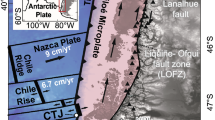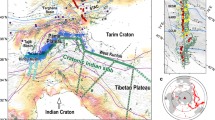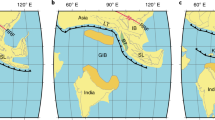Abstract
The 1981 French–Chinese expedition to Tibet focused on the Lhasa block, extending earlier coverage 400 km north of the Tsangpo suture. The Lhasa block stood between 10 and 15° N latitude over most of the Upper Cretaceous and Eocene and, if Gondwanian in origin, had detached from Gondwana by early Permian. Seismic profiles reveal a complex Moho topography resulting both from multiple continental thrusting and large-scale strike-slip faulting. Subduction related granitoids representing mixtures of mantle and crustal components and anatectic granitoids have been analysed and dated. This study emphasizes the role of smaller blocks in the accretion of the continental mosaic.
This is a preview of subscription content, access via your institution
Access options
Subscribe to this journal
Receive 51 print issues and online access
$199.00 per year
only $3.90 per issue
Buy this article
- Purchase on Springer Link
- Instant access to full article PDF
Prices may be subject to local taxes which are calculated during checkout
Similar content being viewed by others
References
Tapponnier, P. et al. Nature 294, 405–410 (1981); Résultats de la coopération francochinoise au Tibet (mission 1980) (eds Mercier, J. L. & Guangqin, Li) (CNRS, Paris, in the press).
Tapponnier, P., Mercier, J. L., Armijo, R., Tonglin, H. & Ji, Z. Nature 294, 410–414 (1981).
Nicolas, A. et al. Nature 294, 414–417 (1981).
Pozzi, J. P. et al. Nature 297, 319–321 (1982).
Colloque Franco–Chinois sur la Géologie de l'Himalaya, Abstr. Guilin (1982).
Chang Chenfa & Cheng Hsilan, Sci. Sinica, 16, 257–265 (1973); in Proc. Symp. on Qingai-Xizang (Tibet) Plateau, (Gordon & Breach, New York, 1981).
Westphal, M., Pozzi, J. P., Yaoxiu, Zhou, Lisheng, Xing & Xianyao, Chen, Geophys. J. R. astr. Soc. 73, 507–521 (1983).
Maluski, H., Proust, F. & Xuchang, Xiao, Nature 298, 152–154 (1982).
Hsü, J. Scient. Geol. Sinica 10, 323–331 (1978).
Schang, Y. 5th int. palyn. Conf., (Cambridge University Press, 1980).
Buffetaut, E. Bull. Soc. géol. Fr. 23, 587–593 (1981).
Ingavat, R. & Janvier, P. Geobios 14, 725 (1981).
Burg, J. P., Proust, F., Tapponnier, P. & Guoming, Cheng . Eclog. Helv. (submitted).
Shackleton, R. J. struct. Geol. 3, 97–101 (1981).
Bally, A. W. et al. U.S. geol. Surv. Open File Rep. 80–501 (1980).
Marcoux, J. et al. Ofioliti Suppl. 6, 31–32 (abstr.) (1981).
Anderson, D. Nature 297, 391–393 (1982).
Dupré, B. & Allègre, C. J. Nature 303, 142–146 (1983).
Hamelin, B., Dupré, B. & Allègre, C. J. Earth planet. Sci. Lett. (in the press).
Hirn, A., Jobert, G., Wittlinger, G., Zhongxin, Xu & Enyuan, Gao, Ann. Géophys. (submitted).
Hirn, A., Nercessian, A., Zhongxin, Zu, Deyan, Lu & Jiwen, Teng, Terra Cognita 3, 267 (1983).
Hirn, A. et al. Nature 307, 23–25 (1984).
Barazangi, M. & Ni, J. Geology 10, 179–185 (1982).
Mattauer, M. C. R. hebd. Séanc. Acad. Sci., Paris 296, 481–486 (1983).
Seeber, L., Armbruster, J. G. & Quittmeyer, R. in Zagros-Indukush–Himalaya Geodynamic Evolution (eds Gupta, H. K. & Delany, F. M.) 215–242 (1981).
Burg, J. P., Guiraud, M. & Guoming, Cheng, Earth planet. Sci. Lett. (submitted).
Argand, E. C. r. Congr. géol. int. 13, 171–372 (1924).
Ben Avraham, Z., Nur, A., Jones, D. & Cox, A. Science 213, 47–54 (1981).
Nur, A. & Ben Avraham, Z. J. geophys. Res. 87, 3644–3661 (1982).
Tapponnier, P., Mattauer, M., Proust, F. & Cassaigneau, C. Earth planet. Sci. Lett. 52, 355–371 (1981).
Tapponnier, P. & Molnar, P. Nature 264, 319–324 (1976); J. geophys. Res. 82, 2905–2930 (1971).
Forsyth, D. & Uyeda, S. Geophys. J. R. astr. Soc. 40, 465–474 (1975).
Armijo, R., Tapponnier, P., Mercier, J. L. & Tonglin, Han, EOS 63, 1093 (1982).
Molnar, P. & Tapponnier, P. Science 189, 419–426 (1975).
Bird, P. J. geophys. Res. 84, 7561–7571 (1979).
Allègre, C. J., Dupré, B., Richard, P., Rousseau, D. & Brooks, C. Earth planet. Sci. Lett. 57, 25–34 (1982).
Burg, J. P. thesis, Montpellier Univ. (1983).
Geological map of the Tibetan Plateau, 1/1,500,000, Chengdu, China 1981).
Author information
Authors and Affiliations
Rights and permissions
About this article
Cite this article
Allégre, C., Courtillot, V., Tapponnier, P. et al. Structure and evolution of the Himalaya–Tibet orogenic belt. Nature 307, 17–22 (1984). https://doi.org/10.1038/307017a0
Received:
Accepted:
Issue Date:
DOI: https://doi.org/10.1038/307017a0
This article is cited by
-
Three-dimensional kinematics of the India–Eurasia collision
Communications Earth & Environment (2023)
-
Pre-Cryogenian stratigraphy, palaeontology, and paleogeography of the Tibetan Plateau and environs
Science China Earth Sciences (2023)
-
Timing and mechanisms of Tibetan Plateau uplift
Nature Reviews Earth & Environment (2022)
-
Classification of the dolomites of Cretaceous Kawagarh Formation in Hazara Basin North-west Himalayas Pakistan: Evidence from field investigation, petrographic analysis and isotopic studies
Carbonates and Evaporites (2022)
-
The topographic evolution of the Tibetan Region as revealed by palaeontology
Palaeobiodiversity and Palaeoenvironments (2021)
Comments
By submitting a comment you agree to abide by our Terms and Community Guidelines. If you find something abusive or that does not comply with our terms or guidelines please flag it as inappropriate.



